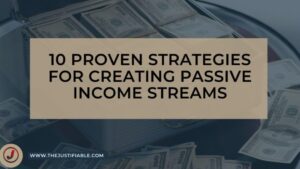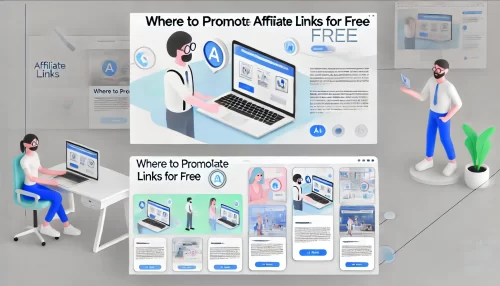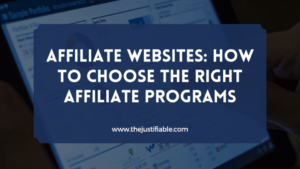Table of Contents
How to promote affiliate products without a website? Many aspiring affiliates believe a website is essential, but that’s not true.
This guide will reveal multiple strategies to succeed in affiliate marketing without owning a website, providing detailed methods, platforms, and tools you can use to generate commissions successfully.
Top Platforms For Affiliate Product Promotion
Promoting affiliate products without a website may seem challenging, but various platforms offer powerful alternatives. By leveraging these tools strategically, you can build a successful affiliate marketing strategy and drive significant commissions without relying on a personal website.
Harnessing Social Media For Affiliate Marketing Success
Social media platforms are goldmines for affiliate marketers. With billions of active users, these channels allow you to reach a wide audience. I suggest using platforms where your target audience spends the most time, such as Instagram or Facebook.
You can post visually engaging content that incorporates affiliate links in captions or stories. Focus on solving problems for your audience, recommending products that genuinely add value. Authenticity matters—your audience should feel you genuinely believe in the products you promote.
Joining niche communities on platforms like Reddit or Facebook Groups can also be highly effective. Engaging in discussions and sharing your affiliate links organically builds trust. Just remember to follow group rules and avoid being overly promotional.
Paid promotions on platforms like Instagram can amplify your efforts. These allow you to target specific demographics, ensuring your affiliate links reach the right people. You can start small with ads and increase your budget as you see results.
Another approach I recommend is creating engaging reels or short videos. Social media algorithms favor video content, which can boost your visibility and increase clicks on your affiliate links. Consistency is key to building an audience.
Best Practices For Promoting On YouTube
YouTube is a powerhouse for affiliate marketers. Its visual format allows you to demonstrate the use and benefits of products, fostering trust. I believe creating tutorial videos or unboxing reviews are great ways to engage viewers.
Optimizing video titles and descriptions with your affiliate links ensures they’re easily found. Always disclose affiliate partnerships in your videos and descriptions to build credibility with your audience. Transparency can also keep you compliant with platform rules.
Consistency is essential for success on YouTube. Uploading high-quality content weekly keeps your audience engaged and encourages repeat visits. Videos that provide genuine value to viewers are more likely to generate clicks on affiliate links.
Creating playlists around specific niches helps viewers discover your content. For example, grouping all “top gadget reviews” into a playlist allows potential buyers to binge-watch your videos, increasing affiliate link clicks.
Lastly, interacting with your audience through comments can build trust. Answer questions about the products you promote, share tips, and ensure your audience feels connected to you as a content creator.
Leveraging TikTok To Promote Affiliate Products
TikTok’s rapid growth makes it a unique opportunity for affiliate marketing. Its algorithm favors engaging, short videos that quickly go viral. I suggest focusing on trends while incorporating affiliate product promotions naturally.
Storytelling is key on TikTok. Demonstrating how a product solved a problem in your life can make your promotion relatable and engaging. Be authentic—viewers are savvy and can spot insincerity.
Using TikTok hashtags strategically expands your reach. I recommend researching trending hashtags related to your niche and including them in your video captions. This increases the visibility of your content.
Collaboration with other TikTok creators can enhance your reach. I advise partnering with influencers in your niche to share affiliate promotions. Their established audience can amplify your affiliate marketing success.
TikTok’s link-sharing limitations can be overcome by using a link-in-bio tool. These tools create a landing page with multiple affiliate links, allowing you to maximize earnings from a single link in your TikTok profile.
Promoting Through WhatsApp And Messaging Apps
WhatsApp and messaging apps offer direct and personal communication channels for affiliate marketing. Sharing your affiliate links with friends, family, and niche groups can yield high conversion rates.
Broadcast lists are excellent for targeting specific groups with promotions. I recommend creating lists based on interests, ensuring that your affiliate messages are relevant to recipients. Personalized messages enhance engagement.
Groups are another effective method. Joining niche-focused groups or creating your own can establish you as an expert. Be helpful and share affiliate links as solutions rather than blatant promotions.
Multimedia messages with images or videos boost engagement. A video explaining how to use a product or an image showcasing its benefits can make your promotions more compelling.
Building trust is crucial when promoting via messaging apps. I suggest being transparent about your affiliations and focusing on recommending genuinely useful products. This approach ensures long-term success.
Maximizing Email Marketing Without A Website
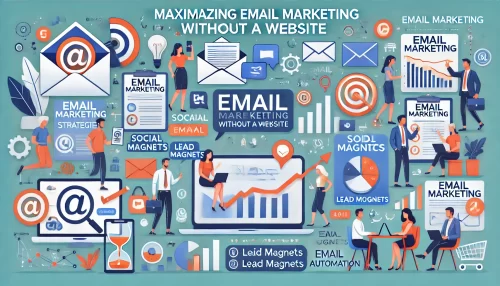
Email marketing offers an effective way to reach and engage potential buyers without the need for a website. I recommend focusing on personalization and providing value through your email campaigns to achieve success.
Crafting Persuasive Emails To Drive Conversions
A well-crafted email grabs attention and drives action. I advise writing captivating subject lines to improve open rates. Your email should deliver value and lead readers toward your affiliate links naturally.
Use storytelling to highlight the product’s benefits. Sharing personal experiences or customer success stories creates an emotional connection, increasing the likelihood of a click. Always include a clear call-to-action at the end.
Segment your email list to tailor messages to different audience groups. For instance, send product recommendations to those who’ve shown interest in similar items. This ensures your content feels relevant and engaging.
Design plays a role, too. I suggest using a visually appealing layout with images of the affiliate product. Break up text with bullet points to make your emails scannable and engaging.
Including urgency boosts conversions. For example, mentioning limited-time discounts creates FOMO (fear of missing out), prompting readers to act quickly and click your affiliate links.
Building An Email List With Lead Magnets
Lead magnets attract subscribers to your email list. Offering freebies like e-books, checklists, or exclusive discounts in exchange for email addresses is a strategy I highly recommend.
Promote your lead magnet on social media or through guest posts. For example, an e-book on “Top 10 Tools for Fitness Enthusiasts” can attract readers interested in fitness products, aligning with your affiliate promotions.
Ensure your lead magnet provides genuine value. When subscribers trust you as a resource, they’re more likely to open your emails and engage with your affiliate links. I suggest focusing on solving specific problems in your niche.
Creating multiple lead magnets for different audience segments can further enhance list-building efforts. Tailor your lead magnet to specific needs for maximum effectiveness in growing your email list.
Finally, use email automation to nurture subscribers. Send a welcome sequence introducing yourself and the value you provide. Gradually incorporate affiliate links to products that solve your audience’s pain points.
Using Third-Party Email Tools For Promotion
Third-party tools simplify email marketing for affiliate marketers. Platforms like Mailmunch or ConvertKit allow you to send professional emails without a website. I advise leveraging their templates for visually appealing messages.
Segmenting your list within these tools can improve engagement rates. For instance, send personalized offers to subscribers who’ve clicked on similar links before. This ensures your emails feel relevant and targeted.
Automation features save time. I suggest setting up autoresponders to promote affiliate products consistently. For example, create a drip campaign introducing a product’s features over a series of emails.
Third-party tools also offer analytics to track performance. Use this data to refine your strategy. If a particular affiliate product isn’t resonating, pivot to promoting another that aligns better with your audience’s interests.
Focus on compliance with affiliate and email marketing regulations. Always include unsubscribe links and avoid spamming. Respecting your subscribers builds trust and increases long-term affiliate marketing success.
Affiliate Product Promotion Using Forums And Groups
Promoting affiliate products in forums and groups is a smart way to connect with niche audiences who are already interested in your products. I recommend engaging genuinely and contributing value before sharing your affiliate links.
Engaging Effectively In Niche-Specific Forums
Forums are fantastic for finding communities of like-minded individuals. I suggest starting by observing discussions and identifying common pain points that your affiliate products can solve. This allows you to tailor your contributions thoughtfully.
When you’re ready to share, ensure your posts provide actionable advice. For example, if someone is struggling with fitness equipment, recommending an affiliate product with a personal anecdote adds credibility. Always keep the tone friendly and helpful.
Consistency matters. Participate regularly to build a reputation as an expert in the community. I believe trust comes from frequent, value-packed interactions. Once you establish authority, people are more likely to click your affiliate links.
Avoid spamming. Instead, integrate affiliate links naturally into your responses when they genuinely add value. Excessive promotion can harm your credibility and result in removal from the forum.
Strategies For Promoting In Facebook Groups
Facebook groups offer access to engaged audiences within your niche. I recommend joining groups where discussions align closely with the affiliate products you promote. This ensures your contributions resonate with the group.
Engage actively by answering questions, sharing tips, or creating polls to understand the group’s preferences. A well-thought-out post addressing their needs builds trust, increasing the chance of successful promotions.
I suggest using storytelling to share how a product helped you or someone you know. Authentic experiences captivate audiences and make them curious about your recommendations, encouraging them to explore the affiliate product.
Collaborate with group admins when possible. Offering exclusive promotions or discounts for the group can boost your credibility. Admins often appreciate this approach, increasing the likelihood of approving your posts.
Maintaining Compliance With Group Guidelines
Every group has its own rules. I advise carefully reading and understanding these before sharing any affiliate content. Compliance shows respect for the community and prevents you from being removed.
Refrain from sharing direct affiliate links in groups where it’s prohibited. Instead, focus on providing value through informative posts, and invite interested members to message you for more details. This approach keeps you within the rules.
Pay attention to how others promote products in the group. Adopting similar methods ensures your posts blend naturally while staying compliant. Group members will appreciate your contributions when you prioritize their interests.
If you’re unsure about specific rules, reach out to group admins. I’ve found that seeking permission can open doors for creative promotions while building goodwill with the community leaders.
Using Paid Advertising For Affiliate Campaigns
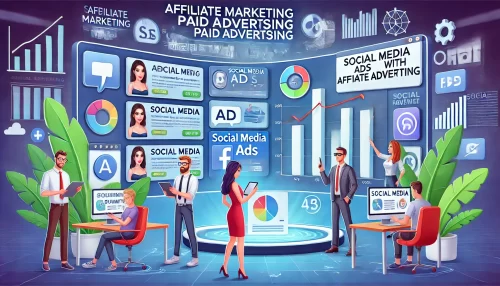
Paid advertising is an excellent way to scale your affiliate marketing efforts. I suggest starting with a small budget, testing different campaigns, and analyzing the results to find what works best for your audience.
Setting Up Cost-Effective Google Ads Campaigns
Google Ads is a powerful tool for promoting affiliate products. I recommend starting with keyword research to identify terms your audience is searching for. Using these terms in your ad copy makes it more relevant and effective.
Targeting long-tail keywords helps reduce competition and costs. For example, instead of targeting “fitness equipment,” focus on “best home gym setups for beginners.” This strategy improves your chances of converting clicks into sales.
Use enticing ad copy. I suggest highlighting the product’s benefits and including a strong call-to-action, such as “Discover how this product transforms your fitness journey.” This creates curiosity and prompts clicks.
Monitor performance regularly. Google Ads provides insights into click-through rates and conversions. Adjusting your campaigns based on these metrics ensures you’re spending your budget wisely and improving your results.
Leveraging Facebook Ads Without A Landing Page
Facebook Ads can drive traffic to affiliate products even without a website. I believe the key is to create visually appealing ads that grab attention and spark curiosity.
Focus on targeting specific demographics. For instance, if you’re promoting beauty products, you could target women aged 20-40 interested in skincare. This narrows your audience and increases ad relevance.
Craft engaging ad copy that resonates with your audience’s needs. A line like “Struggling with dry skin? Discover the ultimate moisturizer” speaks directly to their pain point, making them more likely to click.
Test multiple ad variations. Different headlines, images, and formats can perform differently. I recommend experimenting to find the combination that generates the highest engagement and conversions.
Running Instagram Ads To Target Your Audience
Instagram’s visual nature makes it ideal for affiliate promotions. I suggest using high-quality images or videos to showcase products in action. Visual appeal plays a huge role in capturing your audience’s interest.
Reels and Stories ads are particularly effective. I believe short, engaging videos with clear calls-to-action like “Swipe up to learn more” can drive significant traffic to your affiliate links.
Targeting the right audience ensures your ads reach people likely to convert. Use Instagram’s targeting options to select demographics, interests, and behaviors that align with your niche.
Include user-generated content in your ads. For example, featuring a happy customer using the product adds authenticity. People trust real experiences more than polished promotional content.
Partnering With Influencers To Boost Sales
Working with influencers is a game-changer for promoting affiliate products. Their established audiences trust their recommendations, making influencer collaborations a powerful strategy to drive sales and grow your affiliate marketing success.
Finding The Right Influencers For Your Niche
Identifying influencers who align with your niche is essential. I suggest starting by researching creators who share similar values and target the same audience as your affiliate products. This ensures authenticity and increases the likelihood of conversions.
Micro-influencers are often overlooked but can be highly effective. Their smaller, more engaged audiences typically result in better interaction rates. I recommend reaching out to these influencers for affordable and impactful collaborations.
Assessing engagement is crucial. Look beyond follower count and analyze comments, likes, and shares. An influencer with active discussions on their posts signals an audience that trusts them, which benefits your affiliate marketing efforts.
You can also use influencer platforms like Upfluence or AspireIQ to streamline your search. These tools provide insights into an influencer’s demographics and content performance, helping you make data-driven decisions for partnerships.
Structuring Mutually Beneficial Agreements
Building successful influencer partnerships starts with clear agreements. I believe outlining expectations ensures both parties benefit. Specify deliverables, timelines, and compensation upfront to create a transparent and productive relationship.
Offering influencers a commission-based structure motivates them to prioritize your affiliate products. I suggest providing higher-than-average rates to make your offer competitive and attractive compared to other affiliate opportunities.
Creative freedom is vital for authentic promotions. Allow influencers to share products in their unique voice and style. Their audience connects with their genuine tone, which can significantly boost conversions for your affiliate links.
Discuss metrics to track success, such as clicks, sales, or impressions. Sharing access to analytics creates trust and helps you both measure the campaign’s performance effectively, ensuring future collaborations are even more successful.
Measuring The Success Of Influencer Campaigns
Tracking the effectiveness of influencer campaigns is critical. I recommend using affiliate tracking links or promo codes unique to each influencer. This helps you attribute sales directly and measure ROI accurately.
Analyze engagement metrics like comments and shares. These interactions often indicate how much interest the influencer’s audience has in your product. I’ve found that higher engagement often correlates with better affiliate sales.
Keep an eye on sales spikes during the campaign. Comparing sales data before, during, and after influencer promotions offers insights into their true impact on your affiliate marketing efforts.
Feedback matters. I advise asking influencers about their experiences with the campaign. Their insights can guide adjustments to improve future partnerships, ensuring that both parties benefit even more from future collaborations.
Driving Traffic Through Content Creation On Medium

Medium offers a platform where high-quality content can attract readers and drive traffic to your affiliate links. With its vast audience, creating valuable articles can effectively boost your affiliate marketing strategy.
Writing High-Converting Affiliate Articles On Medium
Crafting engaging articles is key to success on Medium. I suggest focusing on topics that solve your audience’s problems while naturally integrating your affiliate links. Readers appreciate content that educates and provides actionable solutions.
Storytelling is a powerful way to connect with your audience. Share personal experiences related to the affiliate product. For example, explain how the product solved a problem for you, which helps establish trust and credibility.
Include compelling headlines that grab attention. I’ve found that phrases like “Top 5 Tools for Productivity” work well. Engaging introductions and clear calls-to-action ensure readers stay interested and follow through.
Keep articles visually appealing by using images, bullet points, and subheadings. These elements break up the text, making your content easier to read and increasing the likelihood of readers clicking on your affiliate links.
Formatting Content For Better Engagement
Proper formatting enhances the reader experience on Medium. I recommend structuring articles with clear sections, short paragraphs, and bold subheadings to guide readers through the content effortlessly.
Adding visuals like charts or screenshots can make your articles more engaging. For instance, a screenshot showing how a product works can clarify its benefits and boost reader confidence in your recommendation.
Hyperlinking affiliate links naturally within the content ensures a seamless user experience. Avoid overloading the article with links. Instead, use them strategically in high-value sections to encourage clicks without overwhelming readers.
Interactive elements like polls or questions can boost engagement. Encourage readers to share their thoughts in the comments section, fostering community and increasing article visibility on Medium’s algorithm.
Utilizing Medium Tags And Keywords
Tags and keywords on Medium help your content reach the right audience. I suggest researching trending topics and keywords relevant to your niche before writing, as this boosts discoverability.
Use five relevant tags for each article. Tags like “Affiliate Marketing” or “Productivity Tips” help categorize your content, ensuring it appears in searches and recommendations for readers interested in similar topics.
Sprinkle keywords naturally throughout the article, particularly in the title and opening paragraph. Medium’s algorithm favors well-optimized content, so this improves your chances of ranking higher.
I also recommend monitoring the performance of tags and keywords over time. Analyzing which ones generate the most traffic allows you to refine your strategy, ensuring your affiliate articles consistently attract readers.
Capitalizing On Video Content For Affiliate Marketing
Video content is one of the most effective tools for affiliate marketers. It allows you to demonstrate products, build trust, and engage with audiences more personally. I suggest leveraging video platforms creatively to maximize your affiliate sales.
Creating Short Affiliate Videos For Instagram Reels
Instagram Reels are ideal for capturing attention quickly. I recommend focusing on short, engaging videos that showcase the product’s unique features or demonstrate its benefits. This format works especially well for visually appealing products or hands-on demonstrations.
Start your reel with an eye-catching hook, like a problem the product solves. For example, showing a messy kitchen followed by a product that organizes it instantly grabs viewers’ attention. Keep the tone relatable and authentic.
Use trending audio or music to increase your reel’s visibility. Instagram’s algorithm favors content with popular soundtracks, helping you reach a wider audience. I suggest pairing the audio with a visually appealing demonstration for maximum impact.
Close your video with a strong call-to-action (CTA). Encourage viewers to click the link in your bio or DM you for more details. A clear CTA directs interested viewers to the next step, increasing affiliate link clicks.
Keep experimenting with different styles, like “before and after” videos or tutorials. I’ve found that variety keeps your audience engaged and curious about what you’ll post next, which can boost your affiliate marketing results.
Using Live Videos To Engage Potential Customers
Live videos allow you to connect with your audience in real time. I suggest hosting live sessions to showcase affiliate products, answer questions, and build trust with your viewers. This approach adds authenticity and encourages immediate action.
Begin your live session with an introduction and explain what viewers can expect. For instance, if you’re reviewing a product, mention its features, benefits, and why you love it. This helps set the tone and keeps viewers engaged.
Engage with your audience throughout the live session. Respond to comments, address their questions, and share personal experiences with the product. This interaction builds rapport and encourages viewers to trust your recommendations.
Showcase the product in action. For example, demonstrate how a fitness gadget improves your workout. Viewers appreciate seeing the product’s real-world use, making them more likely to purchase through your affiliate link.
End your live with a recap and a CTA, such as “Visit the link in my bio to grab yours now!” I believe this direct approach motivates viewers to act while your presentation is fresh in their minds.
Adding Affiliate Links In Video Descriptions
Including affiliate links in video descriptions is a simple yet powerful way to boost conversions. I recommend writing descriptions that highlight the product’s key benefits and direct viewers to your link for easy access.
Start with a catchy phrase to draw readers in, like “Transform your skincare routine today!” This grabs attention and encourages viewers to read the full description. Pair it with a link that’s easy to click or copy.
Provide details about the product without overwhelming the reader. Mention what makes it unique and how it solves a problem. This information helps build confidence and nudges viewers toward purchasing through your link.
Use link shorteners or tools like Linktree to create clean, clickable links. I’ve found that clutter-free links look more professional and increase the likelihood of viewers clicking on them.
Encourage viewers to share their experiences if they’ve tried the product. This creates a sense of community and boosts credibility, making others more likely to trust your affiliate recommendations.
Sharing Affiliate Links Through Direct Outreach

Direct outreach is a personal way to promote affiliate products. I recommend reaching out to individuals through messaging platforms, emails, or professional networks to share your affiliate links and create meaningful connections.
Personalized Messaging For Higher Conversions
Personalized messages can make your outreach efforts more effective. I advise tailoring each message to the recipient, showing genuine interest in their needs, and presenting your affiliate product as a solution to their specific problem.
Start with a friendly introduction. For instance, if you’re messaging someone interested in fitness, mention your shared passion and explain how you’ve discovered a product that enhances workouts. This personal touch builds rapport.
Highlight how the product can benefit them. For example, share how a home gym setup saved you time and improved your fitness. Personal stories make your message relatable and engaging, increasing the likelihood of a response.
Keep your message concise. People appreciate brevity, so I suggest focusing on key points and ending with a clear CTA, such as “Let me know if you’d like more details!” This keeps the conversation open and friendly.
Follow up respectfully if they don’t respond immediately. Sometimes, people miss messages or need a reminder. A polite follow-up can reignite interest without coming across as pushy.
Reaching Out Through LinkedIn Effectively
LinkedIn is a professional platform where you can connect with potential buyers. I recommend using this network to share affiliate products that align with your connections’ interests or industries.
Craft personalized connection requests. Mention a shared interest or industry topic to initiate the conversation. This approach builds trust and increases the chances of your connection accepting your request.
Share insightful content related to your affiliate product on your LinkedIn feed. For instance, post a detailed review of a productivity tool and include your affiliate link. This educates your audience while subtly promoting the product.
Engage with your connections’ posts to build relationships. Commenting on and sharing their content fosters goodwill, making them more receptive to your messages about affiliate products.
When messaging, focus on the product’s value rather than pushing a sale. For example, explain how it simplifies tasks or saves time. This approach feels helpful rather than transactional.
Strategies For Cold Email Affiliate Outreach
Cold email outreach is an effective way to promote affiliate products when done correctly. I suggest crafting emails that are personalized, concise, and value-driven to capture the recipient’s attention and encourage them to take action.
Begin with a compelling subject line that sparks curiosity. For example, “Struggling with meal prep? Try this solution!” A strong subject line increases open rates and ensures your message gets noticed.
Introduce yourself and explain why you’re reaching out. Mention how you’ve found a product that aligns with their needs. This shows you’ve put thought into your email and builds credibility.
Focus on benefits, not features. Instead of listing product specs, highlight how the product makes life easier or solves a problem. This approach resonates more with recipients and drives engagement.
Include a clear CTA, such as “Click here to learn more!” I recommend using a bold, clickable link to make it easy for recipients to take the next step, increasing conversions for your affiliate product.
Utilizing Free Tools To Simplify Promotions
Free tools are a lifesaver when it comes to streamlining affiliate marketing efforts. I believe leveraging these resources can help you save time, improve efficiency, and maximize the impact of your promotions without extra costs.
Link Shorteners For Better Click-Through Rates
Link shorteners simplify your affiliate promotions. I suggest using tools like Bitly or TinyURL to create clean, clickable links that look more appealing and professional. Short links also make it easier for users to share your content.
Shortened links are less intimidating than long, complex URLs. They’re more likely to catch the eye and earn a click, especially on platforms like social media or messaging apps where character limits matter. I’ve found this boosts engagement significantly.
These tools also provide tracking capabilities. You can monitor clicks, identify top-performing links, and adjust your strategy. This data helps you understand what resonates with your audience and ensures your efforts are effective.
Customizing your links adds a personal touch. For instance, creating a branded URL like “bit.ly/BestGadgetDeals” enhances trust and recognition. This approach helps build credibility, making users more likely to explore your affiliate product.
Lastly, link shorteners are incredibly easy to use. With just a few clicks, you can transform your affiliate links into shareable assets. It’s a small change that makes a big difference in promoting your products.
Free Graphics Tools For Eye-Catching Posts
Visuals play a major role in attracting attention. Free tools like Canva allow you to create stunning graphics for your affiliate promotions. I suggest using these platforms to design professional-quality posts without any design expertise.
A great visual can highlight your product’s benefits. For example, an infographic showing “Top 5 Reasons to Try This Product” is visually engaging and informative. I’ve found this approach boosts curiosity and encourages clicks on affiliate links.
Templates simplify the process. Most free tools offer pre-made designs tailored to social media, emails, and more. I recommend starting with these templates and tweaking them to fit your brand or promotion style.
Consistency matters. Using a similar color palette, font, and design style across your posts helps build recognition. Over time, your audience will associate these visuals with your affiliate promotions, reinforcing trust.
Adding elements like call-to-action buttons or arrows pointing to your links enhances engagement. Simple additions guide your audience and make it easier for them to take action, increasing your chances of conversions.
Free Analytics Tools To Track Performance
Understanding what works is key to improving your affiliate marketing. Free tools like Google Analytics offer valuable insights into your campaigns. I believe tracking performance is essential for long-term success.
These tools help you analyze traffic sources. Knowing where your clicks are coming from lets you focus on platforms that perform well and refine or drop less effective channels, saving you time and energy.
Engagement metrics like bounce rates or time spent on pages show how well your content resonates with users. I suggest using these insights to tweak your messaging and improve audience retention.
Conversion tracking is a must. Free analytics tools can show how many clicks translate into sales. This helps you calculate your ROI and prioritize affiliate products or strategies that yield the best results.
Regularly reviewing data ensures you stay on track. I recommend setting aside time each week to evaluate performance, identify trends, and make data-driven decisions for future campaigns.
Creating Affiliate Product Giveaways
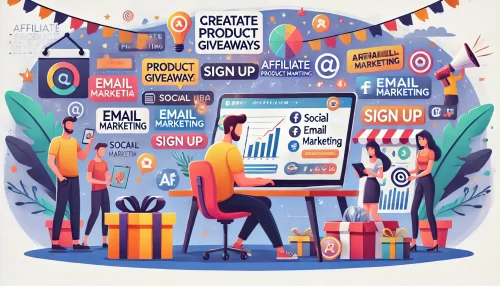
Giveaways are an excellent way to attract attention and encourage participation in your affiliate marketing efforts. I suggest creating exciting campaigns that incentivize users to engage while subtly promoting your affiliate products.
Designing An Irresistible Giveaway Campaign
A well-designed giveaway campaign captures interest and drives engagement. I recommend selecting prizes that align with your niche and resonate with your target audience, making them more likely to participate and share.
Clearly outline the rules. Keep them simple and easy to follow, such as “Follow, Like, and Share to Enter!” Complicated instructions can deter participation, so I suggest focusing on actions that increase visibility for your affiliate product.
Include your affiliate product as part of the prize. This introduces participants to the product, increasing familiarity and trust. Even if they don’t win, they may be inclined to purchase it afterward.
Create a sense of urgency. Mention that the giveaway is for a limited time to prompt immediate action. I’ve seen this technique significantly increase entries, as people don’t want to miss out on the opportunity.
Promote your giveaway through multiple channels. Share it on social media, email newsletters, and even forums. This broadens your reach and maximizes the impact of your campaign.
Promoting Giveaways On Social Media
Social media is the perfect platform for giveaways. I recommend using platforms where your audience is most active, such as Instagram, Facebook, or TikTok, to amplify your campaign and attract entries.
Create eye-catching posts that highlight the prize and steps to enter. For example, a carousel post on Instagram with detailed visuals explaining the rules can grab attention and guide users through the process.
Use stories and reels to keep the momentum going. I suggest posting daily reminders about your giveaway to maintain interest and encourage last-minute entries. Short, engaging clips work best for this purpose.
Collaborate with influencers to boost visibility. Partnering with creators who share your target audience can expose your giveaway to a wider audience, resulting in more entries and affiliate product awareness.
Incorporate hashtags like #Giveaway or #WinThis to improve discoverability. Hashtags help new users find your giveaway and potentially explore your affiliate products, expanding your reach.
Tracking Results To Improve Future Campaigns
Measuring the success of your giveaway campaign is vital. I recommend using analytics tools or manual tracking to evaluate how well it performed and identify areas for improvement in future efforts.
Track engagement metrics like likes, shares, and comments. These numbers show how effectively your giveaway reached and engaged participants, helping you understand what resonated with your audience.
Monitor traffic to your affiliate links during the giveaway. Spikes in clicks or sales can indicate that your campaign successfully encouraged participants to explore your product further.
Collect feedback from participants. Ask them what they enjoyed and what could be improved. Their insights can guide your next giveaway, ensuring it’s even more appealing and effective.
Compare campaigns to spot trends. If certain strategies consistently perform well, incorporate them into future efforts. Over time, refining your approach will result in more impactful affiliate giveaways.
Common Mistakes To Avoid In Affiliate Marketing
Avoiding common pitfalls in affiliate marketing can save you time, money, and effort. I believe understanding these mistakes and proactively addressing them will set you up for long-term success while building trust with your audience.
Oversharing Affiliate Links In Posts
Sharing too many affiliate links can overwhelm your audience. I recommend focusing on quality over quantity, ensuring each link provides value and aligns with your content’s purpose. This keeps your promotions subtle and genuine.
Spamming links reduces credibility. Readers might feel you’re more interested in profits than helping them. Instead, I suggest strategically placing links where they naturally fit into the conversation, increasing engagement and trust.
A cluttered post filled with affiliate links can confuse readers. I believe organizing your content with one or two key recommendations makes it easier for your audience to take action and avoids information overload.
Use a clear call-to-action (CTA) with each link. For example, “Discover how this tool saves time!” makes the link purposeful and encourages clicks. The right CTA can guide your audience effectively without appearing pushy.
Neglecting To Disclose Affiliate Partnerships
Transparency is crucial in affiliate marketing. Failing to disclose partnerships can harm your reputation. I suggest clearly stating your affiliations, as this honesty builds trust and strengthens relationships with your audience.
Adding a short disclosure like “This post contains affiliate links” is simple yet impactful. It shows your readers that you value transparency, which I believe fosters loyalty and encourages them to support your recommendations.
Some platforms and regulations require disclosure. Ignoring these rules can lead to penalties. I recommend staying informed about the guidelines for the platforms you use to avoid any compliance issues.
Being upfront about affiliate links doesn’t deter sales. Instead, it reassures your audience that your recommendations are genuine. I’ve found that honesty enhances credibility and strengthens your position as a trusted resource.
Failing To Research Affiliate Products Thoroughly
Promoting products without proper research can backfire. I advise only endorsing items you’ve tested or trust, as this ensures you’re providing real value to your audience and maintaining your credibility.
Understand the product’s features and benefits. When you know the details, it’s easier to explain how the product solves problems, making your promotions more convincing and relatable.
Look for reviews and testimonials. Researching what others say about the product can provide additional insights. I believe this helps you create content that addresses potential concerns and highlights the product’s strengths.
If possible, use the product yourself. Sharing personal experiences adds authenticity to your promotions. I’ve noticed that audiences respond positively to firsthand stories, making them more likely to engage with your affiliate links.
Tips For Long-Term Affiliate Marketing Success
Sustainable success in affiliate marketing requires consistency, credibility, and adaptability. I recommend focusing on building lasting relationships with your audience while continuously refining your strategies to stay ahead of the competition.
Building A Strong Personal Brand For Credibility
Your personal brand is the foundation of your affiliate marketing efforts. I suggest positioning yourself as a trusted expert in your niche, ensuring your audience sees you as a reliable source of valuable information.
Consistency is key. Maintain a cohesive tone, style, and message across all platforms. I’ve found that a consistent brand identity builds recognition, making your audience more likely to trust and engage with your recommendations.
Share your unique perspective. Whether it’s a personal experience or an expert opinion, adding your voice makes your content stand out. I believe this connection fosters loyalty and keeps your audience coming back.
Engage with your audience regularly. Responding to comments and messages shows that you care about their needs. This interaction strengthens relationships and enhances the credibility of your affiliate promotions.
Networking With Other Affiliate Marketers
Collaboration with fellow marketers can open new doors. I recommend networking to exchange ideas, discover new opportunities, and build a supportive community that helps you grow as an affiliate marketer.
Join affiliate marketing groups or forums. These platforms offer valuable insights and connections. I’ve learned that sharing experiences with peers can inspire new strategies and help you overcome challenges.
Partnering with other marketers can boost your reach. For instance, co-hosting a webinar or creating joint content introduces you to each other’s audiences, expanding your influence and affiliate opportunities.
Attend industry events or virtual meetups. Building relationships with marketers in your niche can lead to collaborations and valuable referrals. I’ve found these interactions to be incredibly rewarding for long-term success.
Staying Updated With Affiliate Marketing Trends
Affiliate marketing evolves constantly. Staying informed about trends and new tools is essential. I suggest dedicating time to learning and adapting your strategies to keep pace with changes in the industry.
Follow reputable blogs or influencers in the affiliate space. These resources provide updates on best practices and emerging trends. I believe this knowledge keeps you competitive and prepared for what’s next.
Experiment with new platforms or techniques. For instance, try promoting products on TikTok or leveraging AI tools for content creation. Embracing innovation can set you apart from other marketers.
Evaluate your performance regularly. Analyzing what works and what doesn’t ensures you’re always improving. This proactive approach keeps your strategies fresh and aligned with your audience’s evolving preferences.



